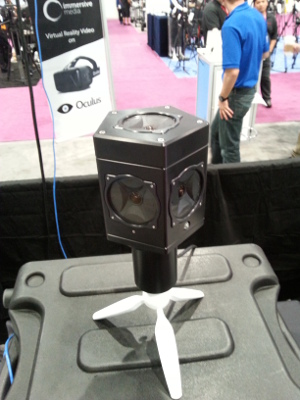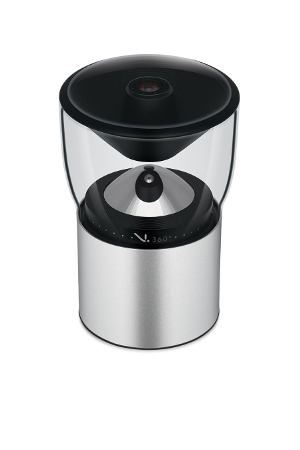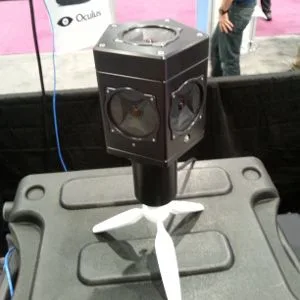There were a lot of developers of 360-degree camera or software companies at NAB – all to feed the growing need for virtual reality content.
NextVR
NextVR was in the RED booth where it was showing stereo content acquired with its stereo rig featuring RED cameras, of course. This was shown in an Oculus headset, which was the limitation in the image quality of the content.
The content was mostly 180-degree capture with a graphic placed in the other half of the immersive environment. The stereo images were quite good and on par with the converted Legend 3D content.
Immersive Media
This company offers stitching software that content creators can use to take multiple camera images and create one large continuous image.
It had a live demo with a 360-degree rig (photo) with real time stitching to show the image in a headset. It was kind of weird to see myself in an immersive environment, but it proved that the stitching works.

The stitching only works on 2D images today, but a 3D solution is not far off, says the company. The output can also be encoded in a ProRes format.
They also have a partnership with Digital Domain, have content on the Samsung MilkVR site, and are working with ABC news to develop the technology for breaking news coverage in 360.
VSN Mobile
VSN Mobile has released a camera called the V.360°. This is similar to the RTI device (see part 1) in that is used a reflective surface (probably spherically shaped to couple to a 4K/16 megapixel imager. It is available now on Amazon for $399.
Video captured by V.360° is recorded onto local storage and can be viewed live or played back later through a free companion app for Android and iOS phones and tablets. The app lets the user pan through a 360-degree video or image to see every angle – or lay it flat, resulting in a very detailed panoramic view.
The V.360° camera is an entirely self-contained device – not an accessory. It captures 360 degree video in full HD (6480 x 1080 pixels) and the imager also incorporates backside illumination for excellent performance even in low-light conditions or underwater. This combination of imager and the unique and patent pending optics means the days of stitching images together to get a complete 360-degree picture are over.

The V.360° camera supports simultaneous video and still pictures and includes built-in GPS sensor to tag locations, a barometer/altimeter and an advanced Qualcomm Snapdragon 800 processor. The Snapdragon 800 processor’s combination of integrated image signal processor (ISP), 2.3GHz quad-core Krait CPU, Qualcomm Adreno 330 GPU and video processor enable the V.360° camera to capture, de-warp and encode 360 degree images at higher frames per second and lower latency because all of this work is done right on the camera, not off in the app.
Video Switch
Video Switch is a stitching software company that is capable of doing live stitching as well as higher quality post production work. Like Immersive Media, their algorithms are designed for 2D content, but a stereo capability should be available in a few months.
They did a live demo to illustrate the capabilities. But it also showed the limitations. For example, when I extended my arm to close to the camera it moved out of the field of view of one of both cameras creating a disconnected image of the end of my arm. The stitching range is apparently adjustable, but clearly tied to the lenses and field of view of the cameras.
Eluminati
Eluminati is a company that offers spherical and dome display solutions, which happen to be ideal for the display and/or review of 180 or 360-degree VR content. In a small stand in the North Hall, they showed a spherical dome illuminated by a Sony 4K projector with a truncated fish eye lens. This worked quite well.

They also offer full 360-degree solutions.
Dashwood Studios
We met up with Dashwood Studios at an evening event where founder Tim Dashwood told us about a new toolkit package he is working on to aid in the creation of 360-degree VR content. He is offering it to beta developers. It allows editing and review of the content with zero latency. This overcomes most problems with other workflows that require a render of the content before it can be reviewed.
Dashwood has a long history in creating 3D content, which is a big asset in the new craze to crate VR content. His toolkit works with a stitching program from Immersive Media, but the fixing of the geometry and stereoscopic parameters are key elements of his toolkit.
Horn and Ivry
This is a small development company that was showing off a VR environment it generated. This was a rendered trip though a space station that allowing a 360-degree look around capability when viewing in an Oculus headset.
They were also able to insert videos into the CG environment, which was pretty cool.

